Kanji for “After,” “Behind,” “Later”: 後 (ato / ushi-ro)
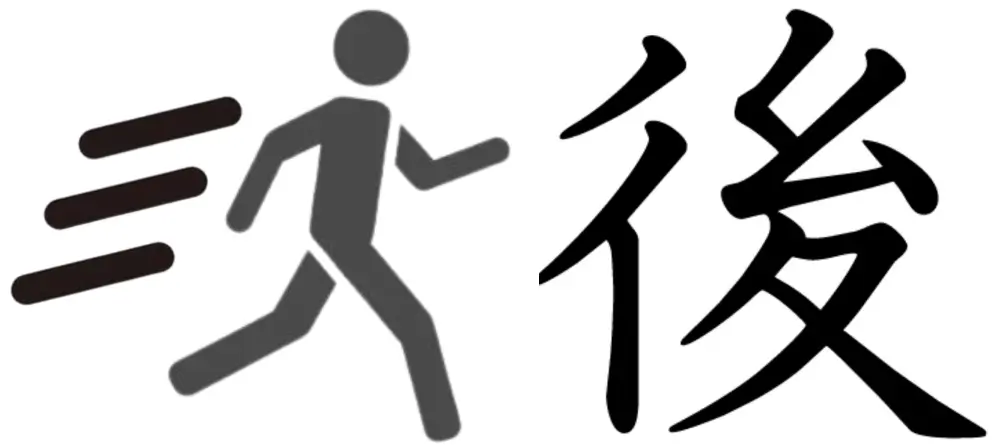
The kanji 後 means “after,” “behind,” or “later.”
The kun’yomi (Japanese reading) pronunciation of the Kanji 後 is ato (あと), meaning “after,” “ushi-ro” (うし-ろ), meaning “behind,” “nochi” (のち), meaning “later,” and “oku-reru” (おく-れる), meaning “be late.” The on’yomi (Chinese reading) pronunciation of 後 is ko (コウ) or go (ゴ).
The meaning of the Kanji 後 extends from relating to time to the position of physical objects or the position of something in a sequence. We will see these contexts later in this article.
後 quite commonly appears in Japanese names and is used in 1350 names. However, in names, it is pronounced as “Koshi” (こし), “shi” (し), “shī” (しい ), or “shiri” (しり ).
The Kanji 後 is constructed with 9 strokes. It is part of the JLPT N5 syllabus (please check the list of JLPT N5 Kanji). In Japanese schools, this Kanji is taught in grade 2.
Origin of the Shape 後
If we see the ancient shape (kyūjitai) of the Kanji 後, it shows the combination of a crossroad, a short thread, and a backward footprint.
The modern shape of the Kanji 後 (shinjitai) is also composed of the above three elements in their evolved shapes, as follows:
- Crossroad, which is a “moving person” kanji radical (彳) and denotes a small step or moving slowly
- “Short thread” radical (幺)
- Backward footprint, which is now known as the “winter radical” (夂) and also means “to go” or “walk slowly”
We will delve into the possible logic later (no pun intended) in this article, but firstly, let’s see the evolution of the shape of the Kanji 後 from ancient times to the current:
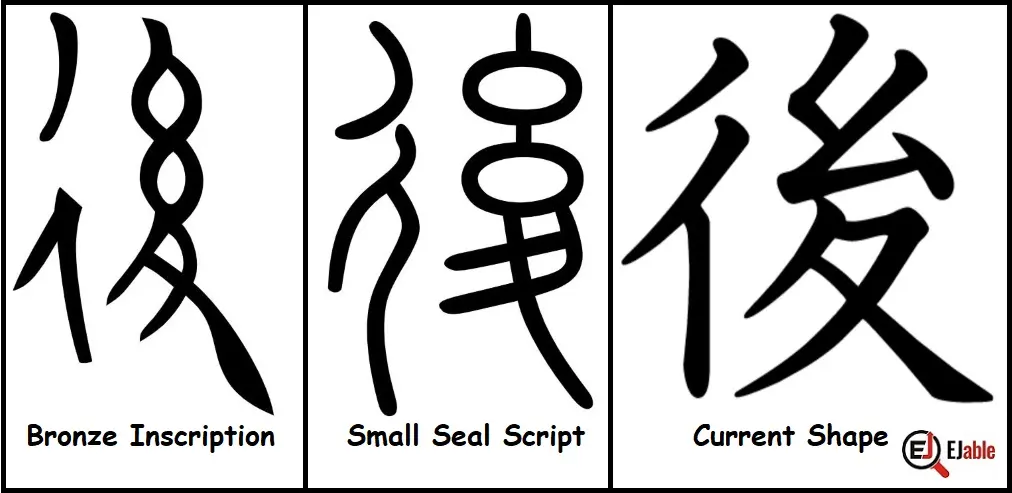

As shown in the above illustrations in the Bronze inscription, and small seal script, the left part shows the crossroad, implying movement, and on the right side, at the top is a short thread, and at the bottom is the element denoting a backward footprint.
In the modern shape or shinjitai, these components have evolved to their evolved shapes and meanings, as explained above.
Mnemonic to Remember the Kanji 後 Meaning “After / Behind”
Logic Behind the Shape 後
Before we move to the mnemonic for remembering the kanji 後, let’s see the logic behind why the three components, i.e., 彳, 幺, and 夂 of 後, may make it mean “after,” “behind,” or “later.”
Radical 彳in 後
The radical 彳 means movement, but a slow movement or taking small steps. This is why its origin comes from the pictograph of a crossroad (derived from the Kanji 行, which means “to go”) where one slows down. The slow movement is directly linked to something left behind or reached later. Moreover, these two concepts relate to the meaning of “after.”
Small Thread 幺
幺 is a part of the Kanji for thread (糸) and is called the “Small Thread” radical. Now if we add smallness further to small steps, it adds the following meanings:
- Further smallness or slowness of the movement
- And weakness, which is one of the properties of a thread—weakness makes a person slow to be left behind and can only make them catch the person in front much later.
Moreover, we can also imagine a person moving on a bridge weak like a tread, which would make a person go slow.
The Component 夂
The component 夂, which otherwise is also a Kanji radical, is an interesting one.
Originally, it was considered to depict a backward footprint. Please check the illustration below:
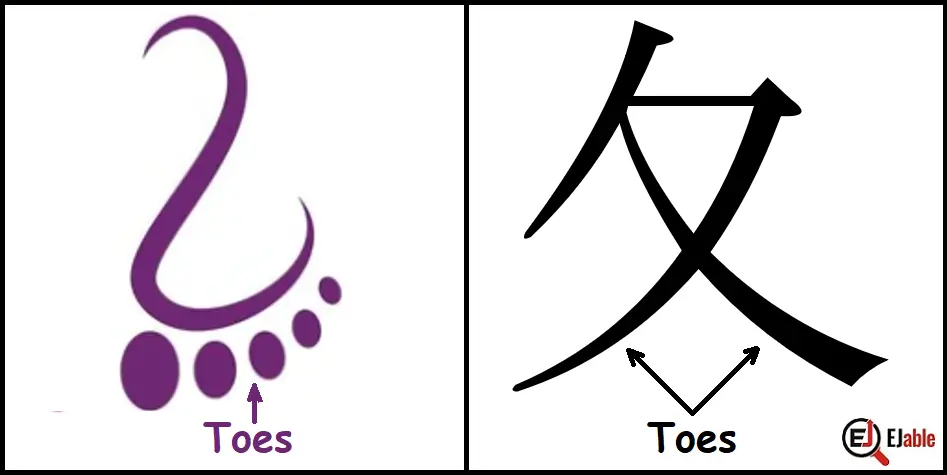

The radical 夂, which is used as a component in the Kanji 後, is now known as the “Winter Radical” and extends its meaning to slow movement.
But why does a shape originally depicting a backfoot extend its meaning to “Winter”?
Consider you are walking on a snowy road; will you be driving fast? You will go slow or even wish to turn back to go to safety. This is where the connection of a backfoot denoting a slow or backward movement with winter comes into the picture.
Now, if we combine the radical “moving person” or slow movement (彳), a short thread (幺), denoting smallness or weakness, and 夂, which again denotes slowness because of weather conditions, it becomes logical that such a combination suggests the idea of “following,” and so, relates its meanings to succeeding events or being behind in position, and hence meaning “after,” “behind,” or “later.”
The combination in 後 suggests the notion of “following,” aligning with its meanings related to succeeding events or being “behind” or “later” in position.
The above logic should be enough to remember the Kanji 後. However, the issue is that one has to know the meanings of the three components of this Kanji. To make it easier, the following illustration can serve as a mnemonic to remember the Kanji 後 for its meaning related to “after,” “behind,” or “later.”:
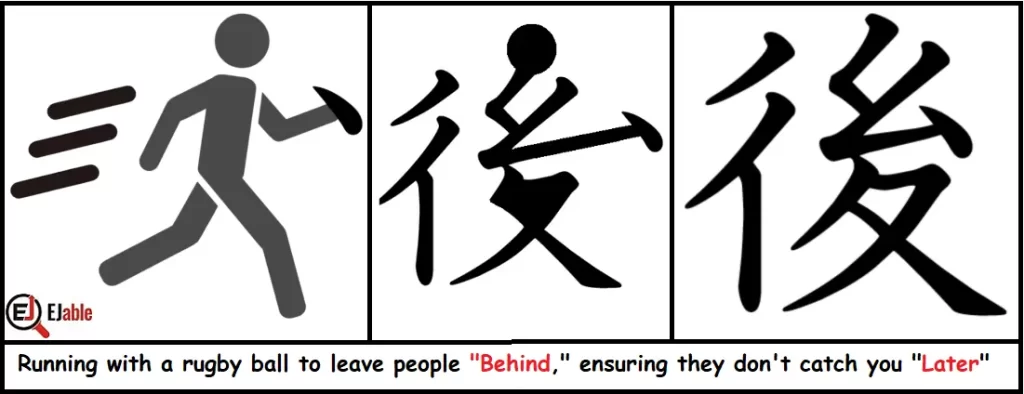

Stroke Order for the Kanji 後
The following illustrations show the order of the 9 strokes to write the Kanji 後:
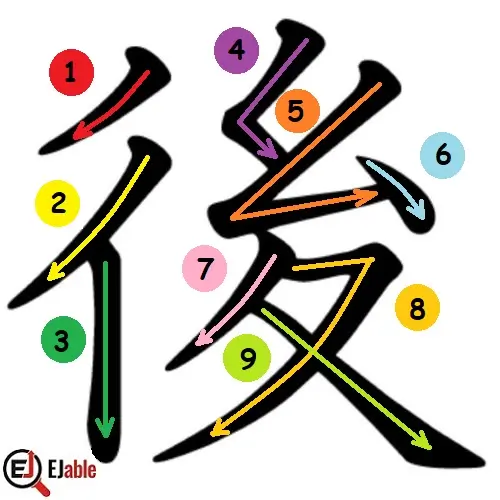

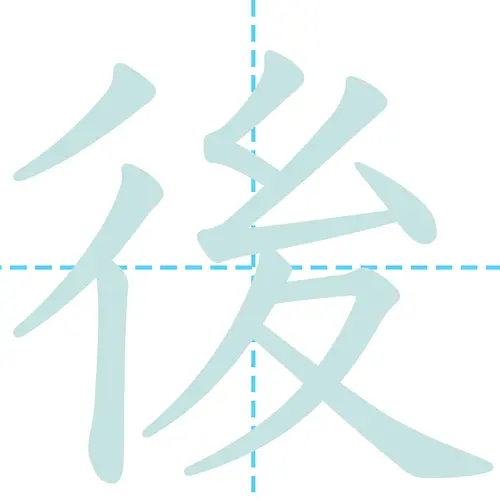

Contexts in Which Kanji 後 is Used
The Kanji 後 is used in the following contexts:
- Time: In the context of time, 後 refers to subsequent times or future events, such as in 後日 (ごじつ / gojitsu), meaning “in the future” or “later on.”
- Position: Spatially, it denotes the area behind something or the back part, as in 後ろ (うしろ / ushiro), meaning “behind” or “back.”
- Sequence: It can also imply order in sequence, such as something coming after something else.
- Descendants: Another less common but culturally significant meaning of 後 involves descendants or heirs, likely connected to the original implication of a ruler and succession.
後 Kanji in Compounded Words
There are 325 Japanese words that begin with the Kanji for “after,” “behind,” or “later” (後), and overall it appears in 511 words.
Examples of Kanji 後 in Compounded Japanese Words
- 後ろ (うしろ / ushiro): Behind— referring to the physical position behind something.
- 以後 (いご / igo): Hereafter— referring to the time following an event.
- その後 (そのご / sono go): After that— referring to the time following a particular event.
- 後悔 (こうかい / kōkai): Regret— literally means a feeling after an action.
- 後継 (こうけい / kōkei): Successor— someone who follows another in a role or position.
- 後者 (こうしゃ / kōsha): The latter— referring to the second of two items mentioned.
- 後退 (こうたい / kōtai): Retreat— the act of moving backward or withdrawing.
- 後半 (こうはん / kōhan): Second half— the latter part of a defined period.
- 後日 (ごじつ / gojitsu): Later date— a time set in the future.
- 後程 (のちほど / nochihodo): Later on— referring to a time shortly after the present.
- 後見 (こうけん / kōken): Guardianship— overseeing someone as a protector or advisor.
- 進学後 (しんがくご / shingakugo): After entering school— referring to the period following school admission.
- 就職後 (しゅうしょくご / shūshokugo): After employment— the time period following the start of employment.
- 回復後 (かいふくご / kaifukugo): After recovery— the time following recuperation from illness or injury.
- 治療後 (ちりょうご / chiryougo): After treatment— referring to the period following medical treatment.
- 死後 (しご / shigo): After death— referring to events or states following death.
- 手術後 (しゅじゅつご / shujutsugo): Post-operation— the period after a surgical procedure.
- 食後 (しょくご / shokugo): After a meal— referring to the time period following eating.
- 出発後 (しゅっぱつご / shuppatsugo): After departure— the time after leaving a place.
- 成績後 (せいせきご / seisekigo): Post-results— referring to the period after academic results are released.
These compound words demonstrate how the Kanji 後 is used to express various concepts relating to time, sequence, and positional relationships, to describe events meaning after, later, or behind.
Note: Check other Kanji characters on the page “How to Learn and Remember Kanji“.


A long-term ex-pat in Japan, Himanshu comes with an IT background in SAP consulting, IT Business Development, and then running the country operations of an IT consulting multinational. Himanshu is the co-founder and Managing Director of ReachExt K.K. and EJable.com. He is also an Advisory Board Member of a Silicon Valley AI/IoT startup.

